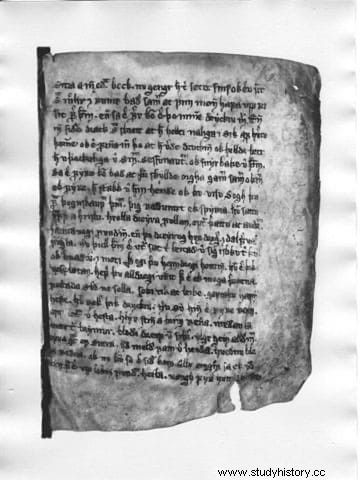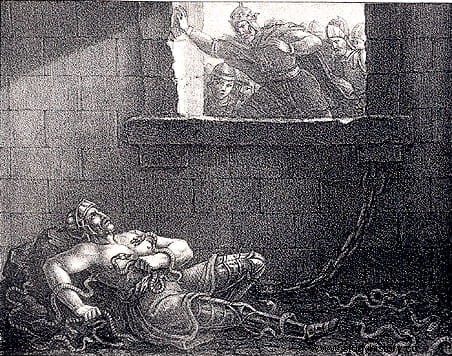Here we have already dedicated several articles to analyzing some characters from the Vikings series from a historical perspective. and, on this occasion, we will continue in that line starting with its main character, Ragnar Lodbrok, to whom until now we had not given the deserved attention.
The first thing to do is remember once again that, like other medieval characters -and not only Scandinavian, because there we have the examples of Arthur or El Cid-, the figure of Ragnar Lodbrok moves between legend and reality without us knowing exactly how much there is of one or the other in his biography, which only increases interest in him. He probably prioritizes the fantastic over the historical, at least if one attends to the confusing chronology attributed to him by the few historiographical sources, which extends for almost a century and a quarter between the years 750 and 865 AD.

The sagas do not clarify things with the precision that in theory they should have about someone of their epic dimensions. There are three that quote Ragnar:the Ragnars saga loðbrókar (Ragnar Hairy Pantyhose Saga), one of the legendary sagas, focuses on him but was written much later, in the early fifteenth century, while the Bósa saga ok Herrauds (Saga of Bósi and Herraud) is barely a hundred years earlier and Ragnar only appears because of his marriage to Herraud; the last one is the Ragnarssona þáttr (Tale of Ragnar's sons). We also have the story Gesta danorum , which the historian Saxo Grammaticus wrote in the 12th century, and the Anglo-Saxon Chronicle , a compilation of texts that does not speak specifically of this Viking but of his context.
From all this it can be deduced that Ragnar brings together not only events that were probably carried out by several different characters at different times throughout those one hundred and fifteen years, but also that he himself would be the result of bringing several of them together into one. A kind of human melting pot. Thus, we can try to conclude some data. According to Grammaticus, he was a Danish Viking of royal blood, descended from the Ynglingeætten (the Old Dynasty), also known as the House of Yngling, from Munsö (for the island of the same name where his tomb is supposed to be), from Uppsala (for the town where the Yngling had their capital) or Ivar Vidfamme (for King Ivar Long Arm , the first of the family); a family clan of Swedish origin whose first members have not proven their historicity.
Ragnar would be the son of Sigurd Ring Randversson, the Danish monarch who after defeating Harald Wartooth in the battle of Brávellir, son of the aforementioned Ivar Vidfamme and king of Gotland (present-day Sweden) upon his death, assumed the joint crown of both kingdoms . His mother was Alfhild Gandolfsdatter, the daughter of Gandalf Alfgeirsson, ruler of the kingdoms of Alvheim and Vingulmark. Therefore, it was a character of lineage whose last name (although in reality Lodbrok is a nickname that means furry leggings , referring to a thick leather pants that he used to wear) continued his sons Björn, Sigurd, Guthrod, Hvitsärk, Rongvald, Ivar the Boneless , Erik, Agnar, Olof, Ingvar, Ubbe and Halfdan.

He had this offspring with three different wives. The first was the famous skjäldmo Lagertha, whom Ragnar divorced not long after their marriage, which is why some sources say she bore him no offspring; from the second, Þóra Borgarhjörtr, she obtained her hand by killing a lindworm (a kind of dragon) that threatened the kingdom, being she the one who made the aforementioned pants and smeared them with tar and sand to resist the burning breath of the beast; the third, which appears in the Völsunga saga , was the exquisite Aslaug, daughter of Sigurd and Brynhild (the Siegfried and Brunnhilde of The Ring of the Nibelung ), which she captivated Ragnar when he caught her bathing in a lake. Besides, the famous Viking also had relationships with other women from whom the last three of the aforementioned offspring would be born.
As you can see, practically everything that surrounds Ragnar Lodbrok is tinged with myth and that also extends to his adventures. These made him famous above all for the incursions he made against the Christian world, on which he liked to launch himself because he considered himself a descendant of Odin, the main Norse god, among whose attributions were magic, wisdom and poetry but also hunting, victory, war and death. Viking custom was to initiate such razzias in summer, when the agricultural season ended and the weather favored navigation, although sometimes they lasted for years. The normal thing was to fall by surprise on the cities, loot them and impose the danegeld , a tribute that guaranteed peace as long as it was paid.

Ragnar's first campaigns were across the Baltic, in the 1940s, defeating the Semigallians and Curonians (peoples of Latvia and Lithuania), as well as the Sambians (Prussians). With those triumphs he became as powerful a monarch as he respected; so much so that, in the absence of enemies, he feared that the Viking nobles would begin to conspire against him, so to keep them entertained he planned an action that would take his fame beyond what he imagined:the siege of Paris around the year 845.
He led a mighty fleet (one hundred and twenty ships are spoken of) to the mouth of the Seine and advanced overland at the head of five thousand men. However, an epidemic broke out with the besiegers threatening to ruin their company and could only be overcome by praying to the Christian God, a good example of the first steps of the new faith among the Vikings... which in reality did not take place until a century later . Finally, Carlos the Bald accepted payment from a rich danegeld to get rid of the intruders (although fourteen years later they would return led by Björn Ragnasson, Ragnar's firstborn).

The truth is that, as we said before, all these feats seem to have been carried out by a handful of historical figures who have been concentrated and fused as one in Ragnar Lodbrok. There are a few names, from King Ragnfrid Halfdansson (who died trying to regain the Danish throne with his brothers in 814) to Ragnall ua Ímair (10th-century Viking monarch of Northumbria), through the chieftain Turgesius (who invaded Ireland in 831) or the sovereign Horik I the Elder (who preceded Ragnar in attacking the Franks), among others.
Now, if there is an episode in the life of Ragnar Lodbrok that has passed into the general imagination, it is the incursion of the year 865 into Northumbria, one of the kingdoms that then made up England before its unification. Tradition says that he had been there before, leading that famous attack on the Lindisfarne monastery that is considered the beginning of the Viking Age; but that happened in the year 793, which makes it impossible for him to take part. This time he did it accompanied by several of his children and facing King Aella, another character of confused history, for some a usurper, for others brother of the previous sovereign Osberht and for all a tyrant.

Aella appears primarily in the saga Ragnarssona þáttr , where it is said that at the head of his Anglos he managed to defeat Ragnar after he ignored Aslaug's warnings about the poor state of his fleet. The Viking chieftain fell prisoner and was executed in a way that is probably more allegorical than real, given the absence of archaeological records in this regard and which often appears in medieval epic tales, not only sagas but also epic poems. :thrown into a pit full of snakes.
To make the legend more literary, it is said that at first Ragnar survived because he used the magical pants that his wife had made for him and that the snakes could not pierce when biting. He only died when they were removed but before that, in a typical literary scene, he prophesied that his "puppies" they would avenge him. And, indeed, the following year all the bells on the British northeast coast rang desperately warning that the sea was full of enemy ships:it was the so-called Great Heathen Army, which brought together hundreds of drakkars and thousands of warriors to devastate the country.

The Anglo-Saxon tradition tells that Björn, Halfdan, Ivar the Boneless were in command. and Ubbe, Ragnar's offspring, just as Ragnar had foretold. With them traveled other jarls United important for that ambitious common enterprise and thus, in effect, they conquered Northumbria at the end of 866 and Estanglia in 870, founding Jorvik, the Viking kingdom of York.
Aella, defeated, knew the taste of vengeance from the Scandinavians suffering the so-called Blood Eagle , a brutal method of execution consisting of opening the prisoner through the back, cutting the ribs and taking the lungs out as if they were wings and then pouring salt inside. Many authors consider that the Blood Eagle it was a pagan sacrificial practice but others consider it rather a fiction typical of skaldic poetry. That is to say, of so uncertain veracity that it fits perfectly in the biography of Ragnar Lodbrok.
More protagonists of the series Vikings:The True Stories.
